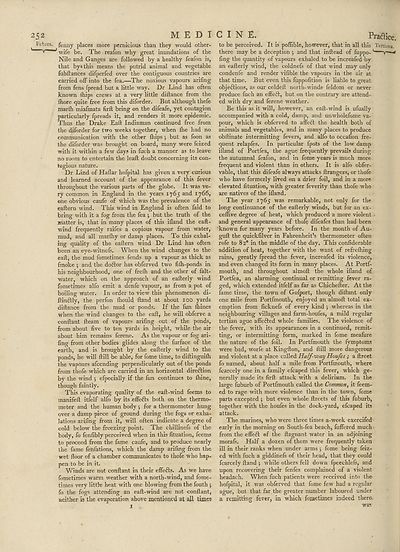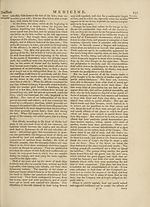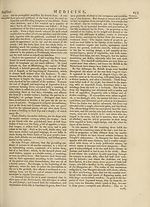Encyclopaedia Britannica, or, a Dictionary of arts, sciences, and miscellaneous literature : enlarged and improved. Illustrated with nearly six hundred engravings > Volume 13, MAT-MIC
(294) Page 252
Download files
Complete book:
Individual page:
Thumbnail gallery: Grid view | List view

2 M E D I
Febres. fenny places more pernicious than they would other-
“"F wife be. The reafon why great inundations of the
Nile and Ganges are followed by a healthy feafon is,
that by* this means the putrid animal and vegetable
fubftances difperfed over the contiguous countries are
carried off into the fea.—The noxious vapours arifing
from fens fpread but a little way. Dr Lind has often
known Ihips crews at a very little diftance from the
fhore quite free from this diforder. But although thefe
marfh miafmata firft bring on the difeafe, yet contagion
particularly fpreads it, and renders it more epidemic.
Thus the Drake Eaft Indiaman continued free from
the diforder for two weeks together, when the had no
communication with the other fhips j but as foon as
the diforder was brought on board, many were feized
with it within a few days in fuch a manner as to leave
no room to entertain the leaft doubt concerning its con¬
tagious nature.
Dr Lind of Haflar hofpital has given a very curious
and learned account of the appearance of this fever
throughout the various parts of the globe. It was ve¬
ry common in England in the years 1765 and 1766,
one obvious caufe of which was the prevalence of the
eaftern wind. This wind in England is often faid to
bring with it a fog from the fea } but the truth of the
matter is, that in many places of this illand the eaft-
wind frequently raifes a copious vapour from water,
mud, and all marfhy or damp places. To this exhal¬
ing quality of the eaftern Avind Dr Lind has often
been an eye-Avitnels. When the wind changes to the
eaft, the mud fometimes fends up a vapour as thick as
fmoke ; and the dodtor has obferved tAvo filh-ponds in
his neighbourhood, one of frefti and the other of falt-
Avater, Avhich on the approach of an eafterly Avind
fometimes alfo emit a denfe vapour, as from a pot of
boiling AVater. In order to vieAv this phenomenon di-
ftindtly, the perfon ftiould Hand at about 100 yards
diftance from the mud or ponds. If the fun ftiines
when the vrind changes to the eaft, he Avill obferve a
eonftant fleam of vapours ariftng out of the ponds,
from about five to ten yards in height, while the air
about him remains ferene. As the vapour or fog ari¬
fing from other bodies glides along the furface of the
earth, and is brought by the eafterly Avind to the
ponds, he Avill ftill be able, for fome time, to diftinguifh
the vapours afcending perpendicularly out of the ponds
from thofe Avhich are carried in an horizontal diredtion
by the Avind ; efpecially if the fun continues to ftiine,
though faintly.
This evaporating quality of the eaft-wind feems to
manifeft itfelf alfo by its effedts both on the thermo¬
meter and the human body ; for a thermometer hung
over a damp piece of ground during the fogs or exha¬
lations arifing from it, will often indicate a degree of
cold beloAV the freezing point. The chillinefs of the
body, fo fenfibly perceived Avhen in this fituation, feems
to proceed from the fame caufe, and to produce nearly
the fame fenfations, which the damp arifing from the
wet floor of a chamber communicates to thofe who hap¬
pen to be in it.
Winds are not conftant in their effedls. As wTe have
{bmetimes Avarm Aveather with a north-Avind, and fome¬
times very little heat Avith one bloAving from the fouth $
fo the fogs attending an eaft-wind are not conftant,
neither is the evaporation above mentioned at all times
CINE. Practice.
to be perceived. It is poflible, however, that in all this Tertiana.
there may be a deception •, and that inftead of fuppo- u' v
fing the quantity of vapours exhaled to be increafed by
an eafterly Avind, the coldnefs of that AAund may only
condenfe and render vifible the vapours in the air at
that time. But even this fuppofition is liable to great
objections, as our coldeft north-winds feldom or never
produce fuch an effect, but on the contrary are attend¬
ed Avith dry and ferene Aveather.
Be this as it will, however, an eaft-Avind is ufually
accompanied with a cold, damp, and unAvholefome va¬
pour, Avhich is obferved to affect the health both of
animals and vegetables, and in many places to produce
obftinate intermitting fevers, and alfo to occafion fre¬
quent relapfes. In particular fpots of the low damp
ifland of Portfea, the ague frequently prevails during
the autumnal feafon, and in fome years is much more
frequent and violent than in others. It is alfo obfer-
vable, that this difeafe always attacks ftrangers, or thofe
who have formerly lived on a drier foil, and in a more
elevated fituation, Avith greater feverity than thofe Avho
are natives of the ifland.
The year 1765 was remarkable, not only for the
long continuance of the eafterly winds, but for an ex-
ceflive degree of heat, Avhich produced a more violent •
and general appearance of thofe difeafes than had been
knoAvn for many years before. In the month of Au-
guft the quickfilver in Fahrenheit’s thermometer often
rofe to 82° in the middle of the day. This confiderable
addition of heat, together with the want of refreftiing
rains, greatly fpread the fever, increafed its violence,
and even changed its form in many places. At Portf-
mouth, and throughout almoft the whole ifland of
Portfea, an alarming continual or remitting fever ra¬
ged, Avhich extended itfelf as far as Chichefter. At the
fame time, the town of Gofport, though diftant only
one mile from Portfmouth, enjoyed an almoft total ex¬
emption from ficknefs of every kind ; Avhereas in the
neighbouring villages and farm-houfes, a mild regular
tertian ague a ft e died whole families. The violence of
the fever, Avith its appearances in a continued, remit¬
ting, or intermitting form, marked in fome meafure
the nature of the foil. In Portfmouth the fymptoms
Avere bad, Avorfe at Kingfton, and ftill more dangerous
and violent at a place called Half-way Houfes ; a ftreet
fo named, about half a mile from Portfmouth, where
fcarcely one in a family efcaped this fever, which ge¬
nerally made its firft attack Avith a delirium. In the
large fuburb of Portfmouth called the Common^ it feem-
ed to rage Avith more violence than in the toAvn, fome
parts excepted $ but even wfiole ftreets of this fuburb,
together with the houfes in the dock-yard, efcaped its
attack.
The marines, who Avere three times a-week exercifed
early in the morning on South-fea beach, fuffered much
from the effedt of the ftagnant Avater in an adjoining
morafs. Half a dozen of them Avere frequently taken
ill in their ranks Avhen under arms j fome being feiz¬
ed with fuch a giddinefs of their head, that they could
fcarcely ftand •, Avhile others fell doAvn fpeechlefs, and
upon recovering their fenfes complained of a violent
headach. When fuch patients wrere received into the
hofpital, it vras obferved that fome few had a regular
ague, but that far the greater number laboured under
a remitting fever, in which foxaetimes indeed there,
was-
Febres. fenny places more pernicious than they would other-
“"F wife be. The reafon why great inundations of the
Nile and Ganges are followed by a healthy feafon is,
that by* this means the putrid animal and vegetable
fubftances difperfed over the contiguous countries are
carried off into the fea.—The noxious vapours arifing
from fens fpread but a little way. Dr Lind has often
known Ihips crews at a very little diftance from the
fhore quite free from this diforder. But although thefe
marfh miafmata firft bring on the difeafe, yet contagion
particularly fpreads it, and renders it more epidemic.
Thus the Drake Eaft Indiaman continued free from
the diforder for two weeks together, when the had no
communication with the other fhips j but as foon as
the diforder was brought on board, many were feized
with it within a few days in fuch a manner as to leave
no room to entertain the leaft doubt concerning its con¬
tagious nature.
Dr Lind of Haflar hofpital has given a very curious
and learned account of the appearance of this fever
throughout the various parts of the globe. It was ve¬
ry common in England in the years 1765 and 1766,
one obvious caufe of which was the prevalence of the
eaftern wind. This wind in England is often faid to
bring with it a fog from the fea } but the truth of the
matter is, that in many places of this illand the eaft-
wind frequently raifes a copious vapour from water,
mud, and all marfhy or damp places. To this exhal¬
ing quality of the eaftern Avind Dr Lind has often
been an eye-Avitnels. When the wind changes to the
eaft, the mud fometimes fends up a vapour as thick as
fmoke ; and the dodtor has obferved tAvo filh-ponds in
his neighbourhood, one of frefti and the other of falt-
Avater, Avhich on the approach of an eafterly Avind
fometimes alfo emit a denfe vapour, as from a pot of
boiling AVater. In order to vieAv this phenomenon di-
ftindtly, the perfon ftiould Hand at about 100 yards
diftance from the mud or ponds. If the fun ftiines
when the vrind changes to the eaft, he Avill obferve a
eonftant fleam of vapours ariftng out of the ponds,
from about five to ten yards in height, while the air
about him remains ferene. As the vapour or fog ari¬
fing from other bodies glides along the furface of the
earth, and is brought by the eafterly Avind to the
ponds, he Avill ftill be able, for fome time, to diftinguifh
the vapours afcending perpendicularly out of the ponds
from thofe Avhich are carried in an horizontal diredtion
by the Avind ; efpecially if the fun continues to ftiine,
though faintly.
This evaporating quality of the eaft-wind feems to
manifeft itfelf alfo by its effedts both on the thermo¬
meter and the human body ; for a thermometer hung
over a damp piece of ground during the fogs or exha¬
lations arifing from it, will often indicate a degree of
cold beloAV the freezing point. The chillinefs of the
body, fo fenfibly perceived Avhen in this fituation, feems
to proceed from the fame caufe, and to produce nearly
the fame fenfations, which the damp arifing from the
wet floor of a chamber communicates to thofe who hap¬
pen to be in it.
Winds are not conftant in their effedls. As wTe have
{bmetimes Avarm Aveather with a north-Avind, and fome¬
times very little heat Avith one bloAving from the fouth $
fo the fogs attending an eaft-wind are not conftant,
neither is the evaporation above mentioned at all times
CINE. Practice.
to be perceived. It is poflible, however, that in all this Tertiana.
there may be a deception •, and that inftead of fuppo- u' v
fing the quantity of vapours exhaled to be increafed by
an eafterly Avind, the coldnefs of that AAund may only
condenfe and render vifible the vapours in the air at
that time. But even this fuppofition is liable to great
objections, as our coldeft north-winds feldom or never
produce fuch an effect, but on the contrary are attend¬
ed Avith dry and ferene Aveather.
Be this as it will, however, an eaft-Avind is ufually
accompanied with a cold, damp, and unAvholefome va¬
pour, Avhich is obferved to affect the health both of
animals and vegetables, and in many places to produce
obftinate intermitting fevers, and alfo to occafion fre¬
quent relapfes. In particular fpots of the low damp
ifland of Portfea, the ague frequently prevails during
the autumnal feafon, and in fome years is much more
frequent and violent than in others. It is alfo obfer-
vable, that this difeafe always attacks ftrangers, or thofe
who have formerly lived on a drier foil, and in a more
elevated fituation, Avith greater feverity than thofe Avho
are natives of the ifland.
The year 1765 was remarkable, not only for the
long continuance of the eafterly winds, but for an ex-
ceflive degree of heat, Avhich produced a more violent •
and general appearance of thofe difeafes than had been
knoAvn for many years before. In the month of Au-
guft the quickfilver in Fahrenheit’s thermometer often
rofe to 82° in the middle of the day. This confiderable
addition of heat, together with the want of refreftiing
rains, greatly fpread the fever, increafed its violence,
and even changed its form in many places. At Portf-
mouth, and throughout almoft the whole ifland of
Portfea, an alarming continual or remitting fever ra¬
ged, Avhich extended itfelf as far as Chichefter. At the
fame time, the town of Gofport, though diftant only
one mile from Portfmouth, enjoyed an almoft total ex¬
emption from ficknefs of every kind ; Avhereas in the
neighbouring villages and farm-houfes, a mild regular
tertian ague a ft e died whole families. The violence of
the fever, Avith its appearances in a continued, remit¬
ting, or intermitting form, marked in fome meafure
the nature of the foil. In Portfmouth the fymptoms
Avere bad, Avorfe at Kingfton, and ftill more dangerous
and violent at a place called Half-way Houfes ; a ftreet
fo named, about half a mile from Portfmouth, where
fcarcely one in a family efcaped this fever, which ge¬
nerally made its firft attack Avith a delirium. In the
large fuburb of Portfmouth called the Common^ it feem-
ed to rage Avith more violence than in the toAvn, fome
parts excepted $ but even wfiole ftreets of this fuburb,
together with the houfes in the dock-yard, efcaped its
attack.
The marines, who Avere three times a-week exercifed
early in the morning on South-fea beach, fuffered much
from the effedt of the ftagnant Avater in an adjoining
morafs. Half a dozen of them Avere frequently taken
ill in their ranks Avhen under arms j fome being feiz¬
ed with fuch a giddinefs of their head, that they could
fcarcely ftand •, Avhile others fell doAvn fpeechlefs, and
upon recovering their fenfes complained of a violent
headach. When fuch patients wrere received into the
hofpital, it vras obferved that fome few had a regular
ague, but that far the greater number laboured under
a remitting fever, in which foxaetimes indeed there,
was-
Set display mode to:
![]() Universal Viewer |
Universal Viewer | ![]() Mirador |
Large image | Transcription
Mirador |
Large image | Transcription
Images and transcriptions on this page, including medium image downloads, may be used under the Creative Commons Attribution 4.0 International Licence unless otherwise stated. ![]()
| Permanent URL | https://digital.nls.uk/192664984 |
|---|
| Attribution and copyright: |
|
|---|
| Description | Ten editions of 'Encyclopaedia Britannica', issued from 1768-1903, in 231 volumes. Originally issued in 100 weekly parts (3 volumes) between 1768 and 1771 by publishers: Colin Macfarquhar and Andrew Bell (Edinburgh); editor: William Smellie: engraver: Andrew Bell. Expanded editions in the 19th century featured more volumes and contributions from leading experts in their fields. Managed and published in Edinburgh up to the 9th edition (25 volumes, from 1875-1889); the 10th edition (1902-1903) re-issued the 9th edition, with 11 supplementary volumes. |
|---|---|
| Additional NLS resources: |
|

